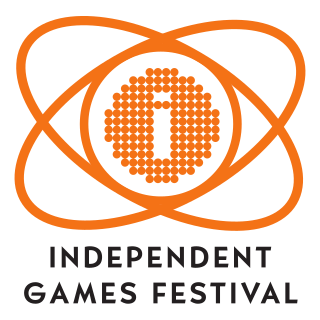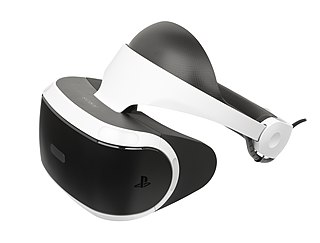
The Independent Games Festival (IGF) is an annual festival at the Game Developers Conference (GDC), the largest annual gathering of the independent video game industry. Originally founded in 1998 to promote independent video game developers, and innovation in video game development by CMP Media, later known as UBM Technology Group, IGF is now owned by Informa after UBM's acquisition.

The Game Developers Conference (GDC) is an annual conference for video game developers. The event includes an expo, networking events, and awards shows like the Game Developers Choice Awards and Independent Games Festival, and a variety of tutorials, lectures, and roundtables by industry professionals on game-related topics covering programming, design, audio, production, business and management, and visual arts.
Owlchemy Labs is a video game developer based in Austin, Texas. The company was founded in 2010 by Worcester Polytechnic Institute graduate Alex Schwartz. Owlchemy is best known for its virtual reality video games Job Simulator and Rick and Morty: Virtual Rick-ality. In May 2017, the studio was acquired by Google.
Tequila Works S.L. is a Spanish video game developer based in Madrid. Founded in 2009 by Raúl Rubio and Luz Sancho, the company is best known for developing Deadlight and Rime.
Superhot is an independent first-person shooter (FPS) video game developed and published by Superhot Team. Though the game follows traditional first-person shooter gameplay mechanics, with the player attempting to take out enemy targets using guns and other weapons, time within the game progresses at normal speed only when the player moves; this creates the opportunity for the player to assess their situation in slow motion and respond appropriately, making the gameplay similar to strategy video games. The game is presented in a minimalist art style, with enemies in red and weapons in black, in contrast to the otherwise white and grey environment.

Reality Labs, formerly Oculus VR, is a business and research unit of Meta Platforms that produces virtual reality (VR) and augmented reality (AR) hardware and software, including virtual reality headsets such as Quest, and online platforms such as Horizon Worlds. In June 2022, several artificial intelligence (AI) initiatives that were previously a part of Meta AI were transitioned to Reality Labs. This also includes Meta's fundamental AI Research laboratory FAIR which is now part of the Reality Labs - Research (RLR) division.

The PlayStation VR is a virtual reality headset developed by Sony Interactive Entertainment, which was released in October 2016.

A virtual reality headset is a head-mounted device that uses 3D near-eye displays and positional tracking to provide a virtual reality environment for the user. VR headsets are widely used with VR video games, but they are also used in other applications, including simulators and trainers. VR headsets typically include a stereoscopic display, stereo sound, and sensors like accelerometers and gyroscopes for tracking the pose of the user's head to match the orientation of the virtual camera with the user's eye positions in the real world.
Tilt Brush is a room-scale 3D-painting virtual-reality application available from Google, originally developed by Skillman & Hackett.

Batman: Arkham VR is a virtual reality adventure video game developed by Rocksteady Studios and published by Warner Bros. Interactive Entertainment for PlayStation 4 and Windows. Based on the DC Comics superhero Batman, it is part of the Batman: Arkham series and the first installment to use virtual reality headsets, allowing players to experience the game world from Batman's perspective. Arkham VR was released worldwide on October 11, 2016, for PlayStation 4 and on April 25, 2017, for Windows for VR headsets.

Accounting is a virtual reality video game by Crows Crows Crows and Squanchtendo, released on Microsoft Windows for the SteamVR platform in 2016. An updated version with additional content entitled Accounting+ was released on December 19, 2017 for PlayStation VR, and eventually on PC on October 18, 2018. It was later released for Oculus Quest on July 3, 2019.

Robo Recall is a virtual reality first-person shooter game developed and published by Epic Games for Oculus Rift and Oculus Quest platforms. The game was released for the Oculus Rift on March 1, 2017, and an Oculus Quest version titled Robo Recall: Unplugged was released on May 21, 2019. Players that activate their Oculus Touch virtual reality controllers with its software are able to download the game for free.

A virtual reality game or VR games is a video game played on virtual reality (VR) hardware. Most VR games are based on player immersion, typically through head-mounted display unit or headset with stereoscopic displays and one or more controllers.

Beat Saber is a virtual reality rhythm game developed by Slovaks Ján Ilavský, Vladimír Hrinčár, and Peter Hrinčár. The game was published by Czech game developer Beat Games. It takes place in many different surrealistic neon environments and features the player slicing blocks representing musical beats with a pair of brightly-colored sabers. Following an early access release in May 2018, the game was officially released for PlayStation 4 and Windows on May 21, 2019, and for the Meta Quest in standalone mode.

Five Nights at Freddy's: Help Wanted is a 2019 virtual reality (VR) survival horror video game developed by Steel Wool Studios and Scott Cawthon. It is an anthology of different minigames based on the Five Nights at Freddy's franchise, where the player must complete tasks without being jumpscared by homicidal animatronic characters. The minigames are composed of virtual reality adaptations of the main entries in the series in addition to several new experiences. Hidden inside the levels are coins that allow the player to unlock collectable objects and cassette tapes that provide insight into the game's metafictional plot.

Blood & Truth is a first-person shooter developed by London Studio and published by Sony Interactive Entertainment. It was released on May 28, 2019 for the PlayStation 4's virtual reality headset PlayStation VR.

Asgard's Wrath is a 2019 action role-playing game developed by Sanzaru Games and published by Oculus Studios for the Oculus Rift virtual reality headset. In the game, the player assumes control of a Norse god who must guide several mortal heroes to fulfill their destinies. The game received generally positive reviews. Asgard's Wrath 2 was released on the Meta Quest 2 and Meta Quest 3 in 2023.

NeosVR is a free-to-play, massively multiplayer online, virtual reality application created by Solirax. It was released for free on Microsoft Windows via Steam on May 4, 2018, with support for several VR headsets.














